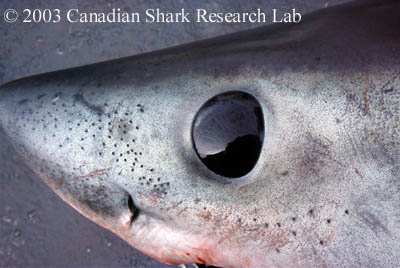Ampullae of Lorenzini
The ampullae of Lorenzini are small vesicles and pores that form part of an extensive subcutaneous sensory network system. These vesicles and pores are found around the head of the shark and are visible to the naked eye. They appear as dark spots in the photo of a porbeagle shark head below. The ampullae detect weak magnetic fields produced by other fishes, at least over short ranges. This enables the shark to locate prey that are buried in the sand, or orient to nearby movement.
Recent research suggests that the ampullae may also allow the shark to detect changes in water temperature. Each ampulla is a bundle of sensory cells that are enervated by several nerve fibers. These fibers are enclosed in a gel-filled tubule which has a direct opening to the surface through a pore. The gel (a glyco-protein based substance) has electrical properties similar to a semiconductor, allowing temperature changes to be translated into electrical information that the shark can use to help detect temperature gradients.
